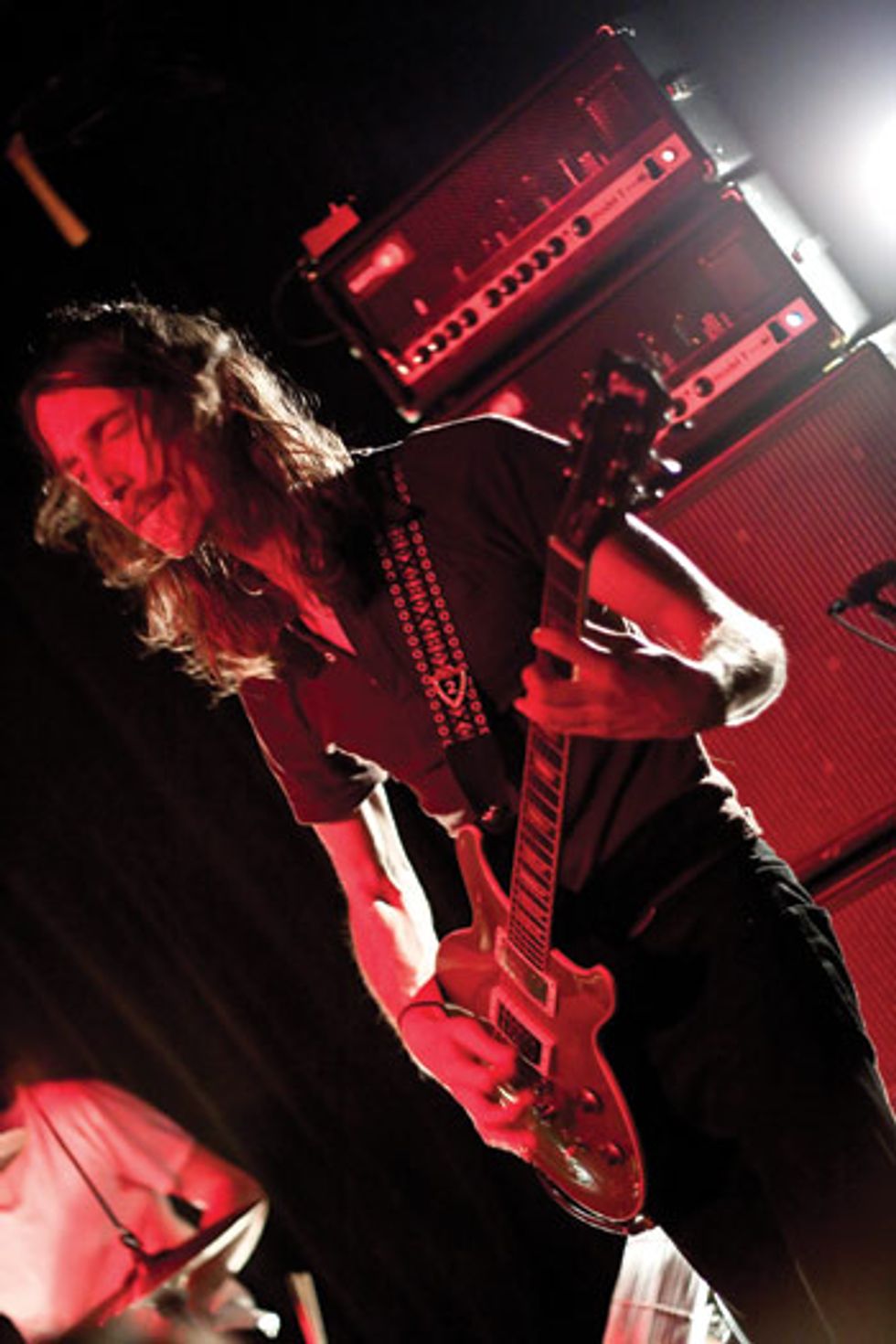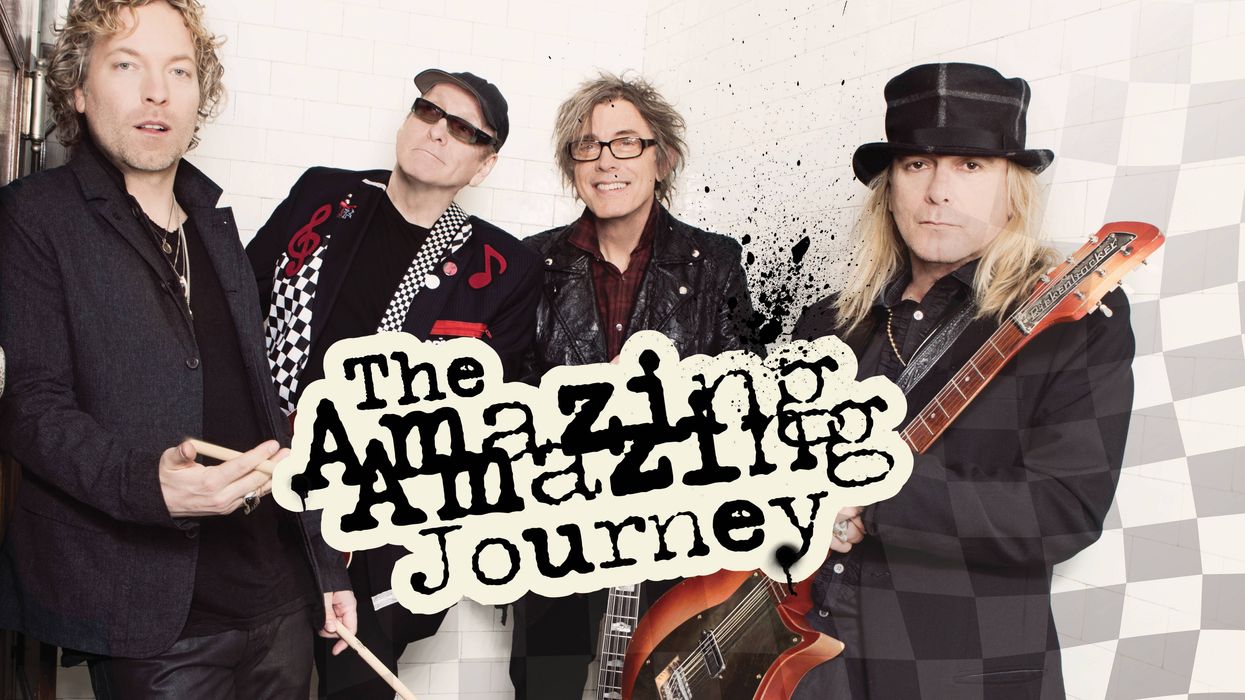Dynamics and texture aren’t normally the first things discussed in interviews with metal guitarists, but Mike Sullivan is a different breed of axeman. As a founding member of the instrumental trio, Russian Circles, Sullivan has spent the better part of five years in a sort of metal monasticism. Forget sweep picking, exotic scales and complex, technical solos; Sullivan chooses to paint his pictures with minimal layers of Les Paul riffs, dissonance and liberal doses of feedback.
Of course, that’s not to say that Sullivan, or Russian Circles by extension, is just another noise-obsessed stargazer; far from it. Songs like “Harper Lewis” and the title track off Circles’ latest full-length album, Geneva, lay some serious sonic wood. All at once, Sullivan begins machine-gunning riffs, bassist Brian Cook puts down lumbering, ominous bass lines, and you suddenly remember you’re listening to a metal band.
The difficulty for genre purists arises from the fact that those two extremes of spacey, dissonant feedback and full-on metal assault aren’t consistently balanced, or even predictable. The songs don’t build and build and build and then release like every other post-rock group out there, and they certainly don’t align with traditional songwriting staples like “verse,” “chorus,” and “bridge.” Russian Circles’ songs wander and meander and unfold, exploding into walls of harnessed distortion oh so briefly before retreating back into the ether. Sometimes the explosion is more sustained and epic; sometimes it’s non-existent, and you get tense just waiting for one.
It’s music that defies easy categorization—something that rarely flies in today’s marketing-obsessed music business—but Sullivan makes no apologies for it. To him, it’s simply a matter of emotional expression; you either connect with it or you don’t. Listen long enough, and odds are you will.
We sat down with Sullivan to talk about the band’s philosophy, their newest album and find out just what creates his thundering tone.
What was the original inspiration behind Russian Circles, and how did that affect how you approached the music?
We wanted to take a step back from the technical side of instrumental music. Instrumental music has been around for centuries, but in the rock sense it’s cluttered with a lot of bands who have great players, but who lose track of the song and the melody and the rhythm. You just get a whole bunch of notes thrown at you. We just approached it as “less is more” and made an effort to think about the bigger picture. We’re each tweaking our own little things to make the song sound good, which sounds like a no-brainer, but we really had to step back and say, “Less, less, less.” We had to train ourselves to keep it minimal.
As a guitarist, I have to think more about texture and how I’m playing with everybody else. It’s challenging because you have to make sure there’s no void, and if there is, that it’s there for a reason.
What kind of gear are you using to create the different textures and tones you hear on your records?
 Photo: Graham Green |
For example, I play Gibson Les Paul double cutaways, and I’ve played those for a while now. The ones I use are from the Custom Shop in the mid-‘90s, and there’s something about the combination of the chambered body that gives it the low-end, and an ebony fretboard, which kind of holds it together—it gives you clarity through the distortion. With a lot of those chambered guitars, you lose that clarity on the high end, and more importantly, the low end with distortion, so for some reason the ebony really makes a difference. It kind of tightens the loose ends.
Are you only using the LPs? Listening to your albums, it sounds like there are some thinner, more delicate tones that I thought would have been from a single-coil.
Geneva is a sonically different album than the other two—I used all types of guitars on that one—but the first two albums are up and down Les Pauls. Most of the distortion was actually done with a Les Paul Custom, just because I love ebony—I just realized right now; I can’t stop talking about it apparently—but LP Customs sound great with distortion. I don’t know what it is, but the makeup of the woods make it sound nice and clear. But most of the record, short of a Telecaster part here or there, it’s pretty much all Les Pauls.
What kind of amps are you using to create those walls of distortion?
For the last two records, they’ve been all Sunn Model T reissues. The distortion channel on those is absolutely out of control. It can either be the worst thing in the world, or one of the better things in the world, but I’ve come to love it. It’s out of control, bass-heavy distortion that has so much balls to it, that no other amp that I’ve found can match it.
That brutal distortion matches up well with your stylistic precision, it seems, especially when you’re chugging on power chords.
With those, that distortion channel just gives it a little more beef. But ironically, as much as I’m gabbing about that distortion channel, in the last year or so I haven’t been using that at all. I’ve just been using pedals to get the tone I’m looking for. My goal in life was to find the pedal configuration that could match that Sunn tone, and I feel pretty close.
Why are you doing that?
Just because I hate two-channel amps. I hate the idea of them—they’re a pain in the ass.
That’s perhaps the last thing I expected to hear from a guy who has made some fairly heavy albums. Why the hate?
They sound phenomenal, but live they’re a nightmare. You have a certain clean tone, and then you’re jumping up through different distortion or volume levels, and right when you change that channel, things will jump or fall a little bit. And I’m pretty anal, so I just hate when something sounds weird to me. When I went to one channel, life was the easiest thing in the world—playing live was no longer stressful. [laughs]
So what are you playing through live now?
I use a Fender Ram, covered in carpet, with a 10-inch speaker [laughs]. No, I still use the Model Ts. The clean tone is similar to the originals and the old Hiwatts, where there’s a whole lot of headroom—it will go forever before it breaks up. I think that’s the most important thing, to be able to have that clean tone as loud as you need, and then you can build from there.
Tell us about the pedal setup you’ve refined to replicate that Sunn crunch.
I’m giving up all of tone secrets here, but I use a Tube Screamer that’s modded by Keeley, so it has a little more low-end and more output. With the added bass in there, it sounds like a whole different pedal, and you can mix that in with some gain pedals or a boost—the more you add, the cooler it sounds.
You’re hiding it from us, aren’t you?
Alright, alright. [laughs] I use a Fulltone OCD for the full-blown distortion, and I have an MXR Micro Amp. So sometimes I’ll have all three pedals on at one time, and sometimes I’ll have different combinations of the three going. And that’s why I really prefer having a one-channel amp, because I’m in full control of each step of the process of going through the distorted tones. There’s no large jump; I can do that if I want to, but I can also step up, one pedal at a time.
Do you have any other pedals on your board?
I’ve come to like that MXR Carbon Copy a lot, and I use an AKAI Headrush for looping.
Looping would be pretty necessary to replicate your music in a live setting; is it tough to pull off?
Yeah, the difficulty during a set is looping. The songs aren’t that hard to play, frankly. I love playing them, but as far as when I’m concentrating, it’s getting the loops right. A set of bad loops is either going to be very apparent, or the drummer is going to have to play around the loop and make it sound like it resembles music.
Have you found the Headrush easy to use in a live setting?
It’s by far my favorite looper. I’ve tried all different types, and that one just seems to be the most responsive. The minute I step on the pedal, I’m aware that it’s recording—there’s no latency. Some of the other loopers, I hear a slight delay, and that makes live looping virtually impossible, unless you want to play with that mental note, where you start recording a half-second beforehand, but you’ll end up in a mental institution if you play a set like that.
| Mike's Gear Box |
| Guitars: |
| Gibson Les Paul DC Pro w/Bare Knuckle Cold Sweats Gibson Les Paul Customs |
| Amps & Cabs: |
| Sunn Model T Reissue (100W) Emperor 4x12 cabinets w/Vintage 30s Emperor 1x15” cabinet |
| Pedals & Effects: |
| Keeley-modified Tube Screamer Fulltone OCD MXR Micro Amp Electro-Harmonix Memory Man MXR Carbon Copy Akai Headrush |
It’s called Geneva, and I’m really happy about the way it came out. It’s a different record from the other two for sure. We did some more thinking about how this record should be, and mentally, we’re in a different place.
What will people hear differently?
It’s a lot less forgiving, a lot less optimistic. In some ways it’s a lot more mechanical and relentless; it still has a human quality to it, but it’s about cramming the idea down your throat. And not just metal riffs, but conveying an emotion, no matter what it is. We’re not worried about genre, or what’s going to be heavy, or what’s not going to be heavy, but just getting our point across without thinking about it too much. There are some songs that are more delicate and incorporate instruments that we haven’t worked with before—different horns and string parts—but at the same time, there are songs that are completely stripped down and leave you feeling miserable afterwards.
RussianCircles.net




![Rig Rundown: AFI [2025]](https://www.premierguitar.com/media-library/youtube.jpg?id=62064741&width=1245&height=700&quality=70&coordinates=0%2C0%2C0%2C0)












 Shop Scott's Rig
Shop Scott's Rig




![Devon Eisenbarger [Katy Perry] Rig Rundown](https://www.premierguitar.com/media-library/youtube.jpg?id=61774583&width=1245&height=700&quality=70&coordinates=0%2C0%2C0%2C0)








 Zach loves his Sovtek Mig 60 head, which he plays through a cab he built himself at a pipe-organ shop in Denver. Every glue joint is lined with thin leather for maximum air tightness, and it’s stocked with Celestion G12M Greenback speakers.
Zach loves his Sovtek Mig 60 head, which he plays through a cab he built himself at a pipe-organ shop in Denver. Every glue joint is lined with thin leather for maximum air tightness, and it’s stocked with Celestion G12M Greenback speakers.













 Luis Munoz makes the catch.
Luis Munoz makes the catch.




























